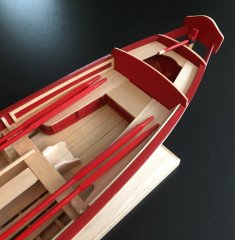
Ben752
-
Posts
64 -
Joined
-
Last visited
Reputation Activity
-
 Ben752 got a reaction from Awas in Program for cutting scanned bulkheads with cnc router?
Ben752 got a reaction from Awas in Program for cutting scanned bulkheads with cnc router?
The zebra analysis tool also has been quite useful in getting a feel for the cursory fairness of the hull.
-
 Ben752 got a reaction from mtaylor in Program for cutting scanned bulkheads with cnc router?
Ben752 got a reaction from mtaylor in Program for cutting scanned bulkheads with cnc router?
The approach I've taken so far follows something like this:
1. Draft the sheer plan on a sketch following the approaches outlined in Steel. I've been using model parameters to define the scantlings to support changing values easily. The description has been very useful for providing traceability.
2. Create a half breadth & body plan sketch.
3. Start building up additional detail on subsequent sketches on the same plane as the sheer, e.g. deck curves, transom details, etc as it seems fusion works best with more sketches with fewer details.
4. Build up the profile of the hull using offset planes at station intervals with sketches representing the details of the body plan.
While I originally used the patch workspace loft command, the t-spline (from the sculpt workspace) loft allows for more flexibility in fairing.
-
 Ben752 got a reaction from herask in Program for cutting scanned bulkheads with cnc router?
Ben752 got a reaction from herask in Program for cutting scanned bulkheads with cnc router?
The approach I've taken so far follows something like this:
1. Draft the sheer plan on a sketch following the approaches outlined in Steel. I've been using model parameters to define the scantlings to support changing values easily. The description has been very useful for providing traceability.
2. Create a half breadth & body plan sketch.
3. Start building up additional detail on subsequent sketches on the same plane as the sheer, e.g. deck curves, transom details, etc as it seems fusion works best with more sketches with fewer details.
4. Build up the profile of the hull using offset planes at station intervals with sketches representing the details of the body plan.
While I originally used the patch workspace loft command, the t-spline (from the sculpt workspace) loft allows for more flexibility in fairing.
-
 Ben752 reacted to druxey in A Dumb Question About Rabbets
Ben752 reacted to druxey in A Dumb Question About Rabbets
The usual convention in drawings shows the rabbet as your version 1. In reality it would look like versions 2 and 3. This was not a dumb question, Dave.
-
 Ben752 got a reaction from Canute in Swan class 3D model in progress
Ben752 got a reaction from Canute in Swan class 3D model in progress
Looks fantastic Greg!
Will there be anyway to see measurements in the 3D model?
I hope the Hornet contract was useful.
Looking forward to getting this to help with my future Atalanta build.
-
 Ben752 got a reaction from PeteB in Swan class 3D model in progress
Ben752 got a reaction from PeteB in Swan class 3D model in progress
Looks fantastic Greg!
Will there be anyway to see measurements in the 3D model?
I hope the Hornet contract was useful.
Looking forward to getting this to help with my future Atalanta build.
-
 Ben752 got a reaction from herask in Swan class 3D model in progress
Ben752 got a reaction from herask in Swan class 3D model in progress
Looks fantastic Greg!
Will there be anyway to see measurements in the 3D model?
I hope the Hornet contract was useful.
Looking forward to getting this to help with my future Atalanta build.
-
 Ben752 reacted to Nirvana in Air Brush Paints
Ben752 reacted to Nirvana in Air Brush Paints
I have only used Valejo paint both the regular and the air version.
Both can be thinned a lot without loosing pigmentation.
I learned something new about the Valejo bottles (a reason not to throw them away once depleted) I was to open my red one and the top came off.
Which was perfect as the paint was clogging up in the tip.
Rinsed it under warm water and the top was as new.
This way I can blend my colors to my own liking and store it without drying out.
The thinner from Valejo is not compatible with MS paint and other acrylics. Tried and the outcome was extremely bad.
-
 Ben752 got a reaction from Landlubber Mike in Sherline has chucks on sale for 20% off in Jan
Ben752 got a reaction from Landlubber Mike in Sherline has chucks on sale for 20% off in Jan
I was looking to get a 4 jaw sometime this year but given their prices rarely are discounted it looks like I'll be getting one this month.
https://www.sherlinedirect.com/index.cfm?fuseaction=product.display&Product_ID=1507&CFID=140895239&CFTOKEN=82798041
-
 Ben752 got a reaction from mtaylor in Sherline has chucks on sale for 20% off in Jan
Ben752 got a reaction from mtaylor in Sherline has chucks on sale for 20% off in Jan
I was looking to get a 4 jaw sometime this year but given their prices rarely are discounted it looks like I'll be getting one this month.
https://www.sherlinedirect.com/index.cfm?fuseaction=product.display&Product_ID=1507&CFID=140895239&CFTOKEN=82798041
-
 Ben752 got a reaction from pompey2 in Very Useful Model Paint Matching/Blending App
Ben752 got a reaction from pompey2 in Very Useful Model Paint Matching/Blending App
I found this very useful app for color matching photos to model paints. It has all of the major paint brands and will calculate blends based off of their published swatches.
While not a foolproof technique, it seems like a decent baseline for approximate matching.
http://www.id6.ch/id6_WebSite_en/iModelKit_v2.html
-

-
 Ben752 got a reaction from Tigersteve in US Brig Niagara by Ben752 – Model Shipways - Scale 1:64 - First wooden ship build
Ben752 got a reaction from Tigersteve in US Brig Niagara by Ben752 – Model Shipways - Scale 1:64 - First wooden ship build
Next, i've framed the supports for the top rail.
I found that using multiple thinner pieces of stock allowed for a nicer curve along the bow. No steam bending necessary when using thinner stock as well.
Sadly, I failed to capture any photos of the laborious process of framing the gun ports. I also used the same technique as xken of using 1/32" square stock to mimic the inner surface of the gun ports and sweeps.
Now onto the body work.
I sprayed 2 coats of the Vallejo grey urethane primer with my airbrush and sanded between coats using 400 grit 3M ultra flexible .
Additionally, I used the bondo spot putty on the inner side of the gun ports to even the surface and hopefully give the appearance of a single board through the full width.
I attempted to color match the red from various photos and settled on the following:
1. 5 parts Vellejo red
2. 6 parts Vellejo amaranth red
3. 1 part flow improver
4. 3 parts thinner
First coat is applied, I'll sand then shoot another 1-2 then apply a matte varnish (again, another fantastic xken tip).
-
 Ben752 got a reaction from Srodbro in US Brig Niagara by Ben752 – Model Shipways - Scale 1:64 - First wooden ship build
Ben752 got a reaction from Srodbro in US Brig Niagara by Ben752 – Model Shipways - Scale 1:64 - First wooden ship build
Next, i've framed the supports for the top rail.
I found that using multiple thinner pieces of stock allowed for a nicer curve along the bow. No steam bending necessary when using thinner stock as well.
Sadly, I failed to capture any photos of the laborious process of framing the gun ports. I also used the same technique as xken of using 1/32" square stock to mimic the inner surface of the gun ports and sweeps.
Now onto the body work.
I sprayed 2 coats of the Vallejo grey urethane primer with my airbrush and sanded between coats using 400 grit 3M ultra flexible .
Additionally, I used the bondo spot putty on the inner side of the gun ports to even the surface and hopefully give the appearance of a single board through the full width.
I attempted to color match the red from various photos and settled on the following:
1. 5 parts Vellejo red
2. 6 parts Vellejo amaranth red
3. 1 part flow improver
4. 3 parts thinner
First coat is applied, I'll sand then shoot another 1-2 then apply a matte varnish (again, another fantastic xken tip).
-
 Ben752 got a reaction from Tom E in US Brig Niagara by Ben752 – Model Shipways - Scale 1:64 - First wooden ship build
Ben752 got a reaction from Tom E in US Brig Niagara by Ben752 – Model Shipways - Scale 1:64 - First wooden ship build
Next, i've framed the supports for the top rail.
I found that using multiple thinner pieces of stock allowed for a nicer curve along the bow. No steam bending necessary when using thinner stock as well.
Sadly, I failed to capture any photos of the laborious process of framing the gun ports. I also used the same technique as xken of using 1/32" square stock to mimic the inner surface of the gun ports and sweeps.
Now onto the body work.
I sprayed 2 coats of the Vallejo grey urethane primer with my airbrush and sanded between coats using 400 grit 3M ultra flexible .
Additionally, I used the bondo spot putty on the inner side of the gun ports to even the surface and hopefully give the appearance of a single board through the full width.
I attempted to color match the red from various photos and settled on the following:
1. 5 parts Vellejo red
2. 6 parts Vellejo amaranth red
3. 1 part flow improver
4. 3 parts thinner
First coat is applied, I'll sand then shoot another 1-2 then apply a matte varnish (again, another fantastic xken tip).
-
 Ben752 got a reaction from Mahuna in Very Useful Model Paint Matching/Blending App
Ben752 got a reaction from Mahuna in Very Useful Model Paint Matching/Blending App
I found this very useful app for color matching photos to model paints. It has all of the major paint brands and will calculate blends based off of their published swatches.
While not a foolproof technique, it seems like a decent baseline for approximate matching.
http://www.id6.ch/id6_WebSite_en/iModelKit_v2.html
-
 Ben752 got a reaction from Canute in Very Useful Model Paint Matching/Blending App
Ben752 got a reaction from Canute in Very Useful Model Paint Matching/Blending App
I found this very useful app for color matching photos to model paints. It has all of the major paint brands and will calculate blends based off of their published swatches.
While not a foolproof technique, it seems like a decent baseline for approximate matching.
http://www.id6.ch/id6_WebSite_en/iModelKit_v2.html
-
 Ben752 got a reaction from Canute in Stevenson's ER32 Collet Blocks
Ben752 got a reaction from Canute in Stevenson's ER32 Collet Blocks
I agree, they are very useful tools. Sherline also sells some, albeit smaller. Their square block is actually an octagon. I plan to get a set to mill the octagonal mast sections on my US Brig Niagra.
http://sherline.com/product/2045-index-block-set/
-
 Ben752 got a reaction from Canute in How serious do you get about dust protection
Ben752 got a reaction from Canute in How serious do you get about dust protection
I use a small vacuum when working and keep a HEPA air cleaner running continuously (it's pretty quiet on the lowest setting, still tolerable on the higher ones).
Even this tiny air purifier has helped quite a bit, however I've yet to graduate to any significant power tools.
-
 Ben752 got a reaction from mtaylor in How serious do you get about dust protection
Ben752 got a reaction from mtaylor in How serious do you get about dust protection
I use a small vacuum when working and keep a HEPA air cleaner running continuously (it's pretty quiet on the lowest setting, still tolerable on the higher ones).
Even this tiny air purifier has helped quite a bit, however I've yet to graduate to any significant power tools.
-
 Ben752 got a reaction from mtaylor in Stevenson's ER32 Collet Blocks
Ben752 got a reaction from mtaylor in Stevenson's ER32 Collet Blocks
I agree, they are very useful tools. Sherline also sells some, albeit smaller. Their square block is actually an octagon. I plan to get a set to mill the octagonal mast sections on my US Brig Niagra.
http://sherline.com/product/2045-index-block-set/
-
 Ben752 got a reaction from mtaylor in Very Useful Model Paint Matching/Blending App
Ben752 got a reaction from mtaylor in Very Useful Model Paint Matching/Blending App
I found this very useful app for color matching photos to model paints. It has all of the major paint brands and will calculate blends based off of their published swatches.
While not a foolproof technique, it seems like a decent baseline for approximate matching.
http://www.id6.ch/id6_WebSite_en/iModelKit_v2.html
-
 Ben752 reacted to wefalck in A Lorch Micro-Mill that never was ...
Ben752 reacted to wefalck in A Lorch Micro-Mill that never was ...
Was kind of working holiday: had to work on finishing off the decoration and furnishing of our part-time home in Spain - putting in/up wardrobes, building a mock fire-place (unfotunately, we can't have real one there), etc.; jumping up and down the ladder at around 30°C made me loose some 4 kg in weight - feeling a lot fitter than before the holidays - but have been to the beach only once ... grilling on the beach in the August heat is for German and British tourists only anyway
************************************
The milling spindle will be secured in its place between the two brackets by a lever-actuated excentric bolt that pushes it down. I found a rough excentric bolt in my scrap-box of odd lathe parts, but it would have been as easy to start from scratch. The excentric was worked over holding the bolt in the 3-jaw-chuck with a brass-shim to give the off-set.
Rough and ready method for excentric turning
The head was turned with the help of the shop-made radius-turning tool (which I originally made to be able to turn miniature door-knobs and the likes). The tool-bit diameter was chosen to match the neck and shoulder of the bolt. The turning operation was followed by smoothing with wet-and-dry paper and steel-wool of various grades. Finally, it was polished with polishing paste. The pictures below show the various steps of this machining process:
To be continued ...
-
 Ben752 reacted to wefalck in A Lorch Micro-Mill that never was ...
Ben752 reacted to wefalck in A Lorch Micro-Mill that never was ...
The long hole for the spindle in the cross-slide was opened up to 5 mm using the Dixi horizontal miller as a boring mill.
Drilling out the the spindle hole in the old top-slide
However, the travel of the slide was too small, so an extension was made to give the slide a travel of around 50 mm, allowing the milling spindle to reach across a face-plate mounted in the dividing attachment on the mill. The extension is a fairly complex piece, fashioned out of a block of aluminium. This is jointed to the existing top-slide with two location pins and two countersunk screws (the holes used were already made by a previous owner).
Top-slide extension (under side)
Top-slide extension (upper side)
To it screws the housing for the y-spindle bearing. Watchmakers lathes usually have simple sliding bearings there, the end-play of which is controlled by a nut with a very fine thread. The elements of this arrangement would have been ground to give a smooth sliding. I decided instead to use miniature thrust-bearings with I.D. of 5 mm and an O.D. of just 10 mm. Two are needed, with the thrust-collar on the spindle in between. This gives an arrangement of 12 mm in length.
Centering the future y-slide spindle bearing-plate in large 4-jaw-chuck
Turning stub for spindle bearing-plate
The bearing-housing was made from a piece of 15 mm x 15 mm aluminium bar. The section was centred in the large 4-jaw-chuck on the lathe and the stub turned on. The piece then was reversed and taken into a 3-jaw-chuck so that the face that screws down onto the slide extension could be turned flat and perpendicular to the axis. The through-hole was drilled and reamed for the spindle. In the next step the seat for the bearings was bored out to exactly 10 mm diameter and a tad unter 12 mm depth.
Reaming bearing for y- spindle
Boring-out seats for thrust ball-bearings
Finally some cosmetic milling operations gave the bearing housing a more elegant shape.
Shape milling of the spindle bearing-plate
To be continued ...
-
 Ben752 reacted to Bob Blarney in How serious do you get about dust protection
Ben752 reacted to Bob Blarney in How serious do you get about dust protection
Power tools produce the greatest and finest airborne dust, and I've started to avoid their use whenever possible. For dimensioning larger boards into smaller stock for model building, hand sawing and hand planing are efficient enough once the techniques are learned, and actually can be quite enjoyable. There's some physical exercise, and it's possible to listen to music or radio discussions, and work at any hour of the day or night. Hand tools do not blow dust everywhere, are less expensive to buy, do not need many replaceable parts and maintenance, and do not occupy a large amount of bench and floor space. Also, hand planing produces a better surface than sanding as well. What's not to like?









